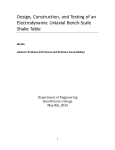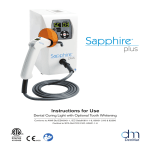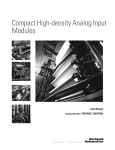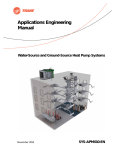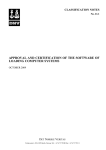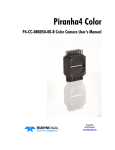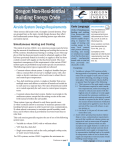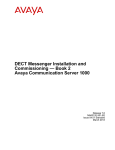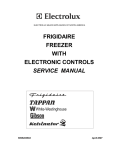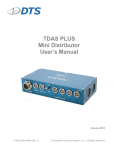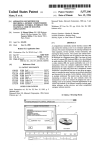Download APPROVAL AND CERTIFICATION OF THE SOFTWARE
Transcript
99- VSbO CLASSIFICATION NOTES No. 21.1 APPROVAL AND CERTIFICATION OF THE SOFTWARE OF LOADING COMPUTER SYSTEMS JUNE 1998 DETNORSKE VERITAS Veritasveien l , N-1 322 H0Vik, Norway Tel.: +47 67 57 99 00 Fax: +47 67 57 99 11 FOREWORD DET NORSKE VERITAS (DNV) is an autonomous and independent Foundation with the object of safeguarding life, property and the environment at sea and ashore. DET NORSKE VERITAS AS (DNV AS), a fully owned subsidiary Society of the Foundation, undertakes classification and certification and ensures the quality of ships, mobile offshore units, fixed offshore structures, facilities and systems, and carries out research in connection with these functions. The Society operates a world-wide network of survey stations and is authorised by more than 120 .l'\ational administrations to carry out surveys and, in most cases, issue certificates on their behalf. Classification Notes Classification Notes are publications which give practical information on classification of ships and other objects. Examples of design solutions, calculation methods, specifications oftest procedures, as well as acceptable repair methods for some components are given as interpretations of the more general rule requirements. An updated list of Classification Notes is available on request. The list is also given in the latest edition of the Introduction- booklets to the "Rules for Classification of Ships", the "Rules for Classification of Mobile Offshore Units" and the "Rules for Classification of High Speed and Light Craft". In "Rules for Classification of Fixed Offshore Installations", only those Classification Notes which are relevant for this type of structure have been listed. Comments may be sent by e-mail to [email protected] For subscription orders or infonnation about subscription tem1s, please use distribution(iifdnv.com Comprehensive information about DNV and the Society's services is found at the Web site http://www.dnv.com C Det Norske Veritas AS 1998 Data processed and typeset by Division Technology and Products, Det Norske Veritas AS Printed in Norway by Det Norske Veritas AS 98-06-05 11 :57 • CN2 l-l .doc 6.98.2000 If an; JlE"S01 Slll'ers ~ a- ~ Wich is µ1lYBl to la'e beEl1 CW!a:I bj an; ri:gi,gert ad a arissiat cl Ost ~ Vettas, then 03t l'mke Vattas stell r»1 ca rpe ISatia1 to su::h Jl9'50'I fer tis p1Mld ctre::t k:6s a- <SraQe 1-o.-, tie c:arpen;atial st-St m e«:eEd M Cll1'tllrt txJ8 to tert 1ilres the fee chaye1 la' tre ser\ice in q.e;lia\ iro.Qd hi tte ITB<ill'Ull ~ shiil re/f!( eiom lID2 mllim CONTENTS 1. Introduction ............................................................. 4 2. Definitions•..•..•..•..•..................•....•....•..•.........•.......... 4 2.l Loading Computer System ..... ...... ... .............. ........ 4 2.2 Approval and certification for a specific vessel... .. 4 2.3 Type approval ........................................................ 4 3. H ow to Obtain Approval a nd Certification for a Specific Vessel .•..•..•..••...................•...•...••...••...•...••............... 4 4. H ow to Obtain T ype Approval... ............................ 6 Appendix A Approval R equest Form for Type Approved Loading Computer Software ............................ 7 Appendix B Approva l Reques t Form for Loading Computer Software........................................................... 10 Appendix C Guidance for Filling in Approval Request Form for Loading Computer Software ........................... IS D ETNORSKE VERITAS 4 Classification Notes No. 21.1 June 1998 1. Introduction 2.3 Type approval This Classification Note is a guidance for those who are involved in the approval and certification of a Loadjng Computer System for a specific ship. J.e. the software manufacturer who wish to have his software approved for a specific ship or the yard which needs an approval and certification of the Loading Computer System installed on board a vessel they are about to deliver. Type approval means that DNV has approved the design, methods and specifications of the software in general. The type approval is given based on a review and acceptance of design, calculation methods and documented test results for at least two test vessels. Type approval certificate is issued. Requirements for Loading Computer Systems for specific ships are given in the Rules for Classification of Ships, Pt. 6 Ch.9. This Classification Note is also guidance for those manufacturers who wish to have their software type approved. In the type approval certificate it will be stated what kind of calculations the type approval covers. The type approval will be included in the DNV register of Type Approved Products, file no. 780.90. In co1U1ection with approval for a specific ship with type approved software, less documentation will be required, and Jess fee will be charged. 3. How to Obtain Approval and Certification for a Specific Vessel 2. Definitions The following stepwise procedure applies: 2.1 Loading Computer System 2.2 Approval and certification for a specific vessel 1) The Approval request Form is to be submitted. For type approved software, use the form "Approval Request Form for Type Approved Loading Computer Software", as given in Appendix A. For not type approved software, use the form "Approval Request Form for Loading Computer Software", as given in Appendix B. It must be clearly stated for wl1at parts of the software the approval is requested. Approval of software means that DNV approves the software for a specific installation onboard a specific vessel. The approval is based on a review and acceptance of design, calculation method, verification of stored data and test calculations for the specific vessel. 2) Upon receipt of the filled in form, DNV will indicate the fee for the approval and certification. Fees of approval are dependent on the applications to be approved. These fees are reduced for type approved software and they are reduced for sister vessels. Approval of the software is to be carried out for each specific vesseJ where the software is to be installed. 3) Documentation as listed in the Rules for Classification of Ships, Pt.6 Ch.9 Sec.2 is to be submitted for approval. Approval of the software results in approved test conditions. 4) When the submitted data has been checked and found in A loading computer system is a computer based system for calculation and control of loading conditions for compliance with the applicable stability, longitudinal and local strength requirements. The loading computer system consists of software (calculation program) and the computer (hardware) on which it runs. order, the approved test conditions will be returned. If the software is type approved, the review and acceptance of design is not necessary for each specific vessel. Only verification of user's manual, stored data and test calculations for the specific vessel will then be carried out. 5) When the software has been approved for the specific vessel, certification is to be carried out as described in the Rules for Classification of Ships, Pt.6 Ch.9 Sec.3. Certification (installation testing) is canied out to ensure that the loading computer system works properly onboard the specific vessel, and to ensure that the correct approved version of the software has been installed. Certification is to be carried out for each vessel where a loading computer system has been installed. Loading Computer Certificate, DNV Form no. 60.00a is issued. DET NORSKE VERITAS s Classification Notes No. 21.1 June 1998 r----------------------------Approval Documentation according to the Rules for Classification of Ships, Pt.6 Ch.9 Sec.2 to be submitted to DNV for approval. t DNV check the documentation and return approved test conditions I I i I I I ~-----------------------------------------------~----------------------------------------------Certification Test for certification (installation testing) is to be carried out either onboard or at the manufacturer Either· or Test for certification at the manufacturer: Test for certification onboard: The test is to be witnessed by the DNV Surveyor The test is to be witnessed by a DNV Surveyor - The DNV Surveyor witnessing the test issues the Loading Computer Certificate - The DNV Surveyor witnessing the test issues the Loading Computer Certificate Master is to: - Verify that approved loading computer software is installed on hardware as listed in the loading computer certificate, - Verify that the system works properly onboard. - Sign and submitted to DNV the test conditions as calculated and printed onboard. Figure 1 Flow chart summarising procedure for approval and certification of Loading Computer System for a specific ship, (see the Rules for Classification of Ships, Pt.6 Ch.9). DETNORSKE VERITAS 6 Classification Notes No. 21.1 June 1998 Limitations: 4. How to Obtain Type Approval The following stepwise procedure applies: 1) The form "Approval Request Form for Loading Computer Software", as given in Appendix B, is to be filled iri and submitted to DNV. It must be clearly stated for what parts of the software the type approval is requested. 2) Upon receipt of the filled in form, DNV will indicate the fee for type approval. 3) Manufacturer and DNV are to agree on applicable test vessels. The test vessels can either be standard test vessels provided by DNV or other vessels preferred by the manufacturer. The latter can be ships in operation or newbuildings, as suitable. The test vessels must be for at least two different ship types. For calculation programs based on the input of hull form data, test data should be provided for three different ship types. If the DNV standard test ships are applied, the necessary ship data (ship lines, description of compartments, light ship data etc.) will be supplied by DNV. 4) For each of the test vessels, documentation as required in above 3.3) is to be submitted. I.e. documentation as for specific approval for each of the test vessels. Often it is practical to combine the type approval with specific approval for each of the test vessels. If the DNV standard test ships are applied, the calculations required will be described in the data supplied by DNV; definition of cargo and supplies in the test conditions, if relevant, damage cases etc. 5) The type approval is valid only for the calculation results. I.e. the type approval is a confirmation that the software is able to g ive correct results provided that the stored characteristic data of the vessel and the user's input is correct. Renewal: The type approval is valid only for an identified, specific version of the software. Whenever the software is revised, the type approval is no longer valid. In order to get a renewal of the type approval, the manufacturer has to submit the details of the revision and DNV will decide the extent of testing required. The Type Approval Certificate will remain valid for a period of four years. The Certificate will be renewed upon confumation from the manufacturers of the calculation program that the calculation algorithms remain unchanged. Documentation according to the Rules for Classification of Ships, Classification Notes No.21.1 Pt.4 to be submitted to DNV for aouroval. i DNV check the documentation and return the type approval certificate. Figure 2 Flow chart summarising procedure for type approval When the submitted data has been checked and found in order, type approval will be given. Type approval certificate will be issued . D ET NORSKE VERITAS 7 Classification Notes No. 21.J June 1998 Appendix A Approval Request Form for Type Approved Loading Computer Software To be filled in: Ship Name: Name of Ship Yard: Ship Yard Building No.: Software Producer Name and Address: Software Name: Software Version No.: Software Version Date: Type Approval Certificate No.: Type Approval Expiring Date: It should be noted that not all items in the form are requirements. Some of the items are meant for infomrntion while some other items may not be applicable to the software or the ship in question. Reference is made to the Rules for Classification of Ships, Pt.6 Ch.9 Sec. I A400 "General software requirements". To be ticked off, "X": Yes No. Software Description 1. Genera l Jnformation J.J The type approval covers all the strength and stability applications as calculated for this actual vessel l.S The approval is with respect to strength l.6 Approval is with respect to stability lim it curves l.6. 1 The limit curves cover the following stability regulations: .......... ........... ............... ............................... 1.7 Approval is with respect to intact stability calculation including evaluation of criteria against GZ curve l.7. 1 [ntact stability regulations: ..................................................... ... . l.8 Approval is with respect to damage stability calculation including evaluation of criteria against GZ curve 1.8.1 Damage stability regulations: ...................................... .... .... .... l.9 Approval is with respect to grain stability 1.9. 1 Grain stability for untrimmed ends 1.10 Approval is with respect to other applications and regulations: ............................................................ DET NORSKE VERIT AS No NIA • 8 Classification Notes No. 21.l June 1998 2. General Software Specifications 2.12 Loading Limitations are included and the values are included in the stored characteristic data: 2.12.l Minimum draft due to slapiming: 2.12.2 Maximum draft (load line draft): 2.12.3 Maximum GM to limit sloshing in slack tanks: 2.12.4 Minimum GM I Maximum KG due to stability: 2.12.5 Maximum trim due to range of trim covered by stored hydrostatic data, cross curves, limit curves or others: 2.12.6 Cargo tanks and ballast filling (strengtlt/stability), for example when ballast tanks surrounding empty cargo compartments are to be kept full etc.: 2.12.7 Cargo tank filling height as a function of cargo density (strength): 2.12.8 Cargo compatibility: with respect to type of cargo in adjacent compartments: 2.12.9 Limits to distribute loads on deck: the weights on a given deck shall be limited by strength for which the deck is approved.: 2.12.10 Clear warning is given if the loading limitations 1.6, 1.7 1.8 1.9 and 2.12 are not fulfilled: 2.13 Calculation of tank capacities and centre of gravity is included with trim correction 3. Longitudinal strength 3.1 Control of stillwater shear forces against limit values 3.2 Correction of shear forces for bulk carriers 3.3 Correction of shear forces for tankers 3.4 Con~ol 3.5 Control of stillwater stresses, including torsion, 4. Local Strength 4.1 Limits for maximum mass in any hold as a function of draft 4.2 Limits for maximum mass in any two adjacent holds as a function of draft 4.3 Limits to mass in holds as a function of varying angle ofrepose 4.4 Limits to filling heights in tanks as a function of cargo density 4 .5 Limits to distributed loads on decks 4.6 Control of container lashing of stillwater bending moment against limit values DET NORSKE VERITAS 9 Classification Notes No. 21.1 June 1998 s. Stability 5.5 If relevant, calculation and evaluation of severe wind and rolling criteria are included and presented 5.6 If calculation and evaluation of severe wind and rolling criteria are included, both the hull above the water line, the structure on deck and all deck cargo are included in the windage area 5.7 If relevant, calculation of other external heeling moments is included and presented: ................. . ............................................. 5.8 Stored hydrostatics and cross curves are for even keel 5.9 Stored hydrostatics and cross curves are for the range of trim: ..... ... ..... .. .... ... .. 5.10 Limit curve KG/GM is for even keel 5.1 1 Limit curves KG/GM are for range of trim: 8. Documentation to submit 8.1 Filled in approval request fonn (this form) 8.2 User's Manual 8.3 Test Conditions 8.4 Stored Characteristic data 8.5 The documentation is in accordance with the approved onboard Loading and Stability documentation ..................................... . l ~ 8.6 The documentation is as listed in DNV Rules For Ships Pt.6 Ch.9. Sec.2 9. Alterations to the Software 9. 1 Are alterations affecting the results carried out * NIA: Not Applicable "No." refers to Appendix C, Guidance for filling in Approval Request Form for Loading Computer software. " A new version of the software should be given when significant software alterations affecting the results are carried out [f changes affecting the results are made to the software, description of the changes is to be submitted and the type approval might have to be renewed. To be filled io: Place: Date: On behalf of Software Producer: Name: Position: Signature: DETNORSKE VERITAS ,, 10 Classification Notes No. 21.1 June 1998 Appendix B Approval Request Form for Loading Computer Software This approval request form is to be used for specific ships when the software is not type approved. 1t can also be used for application for type approval. Reference is made to the Rules for Classification of Ships, Pt.6 Ch.9 Sec. I A400 "General software requirements." To be filled in: Ship Name* : Name of Ship Yard*: Ship Yard No.* : Software Producer Name and Address: Software Name: Software Version no.: Software Version date: Data Operating System: Requirements for hardware: *To be filled in when the approval is for a specific ship, usually not relevant to be filled in if the approval request is in connection with general request for type approval. It should be noted that not all items in the form are requirements. Some of the items are meant for information while some other items may not be applicable to the software or the ship in question. Reference is made to the Rules for Classification of Ships, Pt.6 Ch.9 Sec. l A400 "General software requirements". To be ticked off, "X" : No. Software Description 1. General Information 1.1 Approval is requested in connection with initial type approval 1.2 Approval is requested in connection with approval for a specific ship 1.3 Approval is requested for calculations for mono-hull ships only 1.4 Approval is requested for calculations for arbitrary floating structures 1.5 The approval is with respect to strength 1.6 Approval is with respect to stability limit curves 1.6.1 The limit curves cover the following stability regulations: . ........ .... ... ..... .... .... ... .. .. ... .. . .. . . . .. .. ... 1.7 Approval is with respect to intact stability calculation including evaluation of criteria against GZ curve Yes DETNORSKE V ERITAS No NIA Ref./Page # Classification Notes No. 21.1 11 June 1998 1.7. l I Intact stability regulations: ~ 'I ····································································· 1.8 Approval is with respect to damage stability calculation including evaluation of criteria against GZ curve 1.8.1 Damage stability regulations: ..................................................................... 1.9 Approval is with respect to grain stability 1.9.1 Grain stability for untrimmed ends 1.10 Approval is with respect to other applications and regulations: ...................................................... 1.11 Approval includes on-line interface 1.11.1 Readings used as on-line input: 1.12 Quality assurance system applied for development and testing: .............................................................................. 1.13 Approval given by other authorities or classification societies: ................................................................ ....... 2. General Software Specifications 2.1 On-line user's task help is provided 2.2 Lightship weight and lightship weight distribution and associated centres of gravity are protected, i. e. can not be changed by user ····························································································· 2.3 The Society's imposed structural limitations are protected, i. e. can not be changed by user 2.4 If included, Geometric hull form data are protected, i. e. can not be changed by user 2.5 Hydrostatic data are protected, i. e. can not be changed by user 2.6 If included, Cross Curves are protected, i. e. can not be changed by user 2.7 Compartment defmitions including frame spacing, and centres of volume, together with capacity tables (sounding/ullage tables), if appropriate are protected, i. e. can not be changed by user 2.8 If included, Limit curves (KG, GM) are protected, i. e. can not be changed by user 2.9 Where relevant, default group of damage cases are protected, i. e. can not be changed by user 2.10 Safeguarding against erroneous input such as overfilling of tanks, filling same tanks twice, etc. 2.11 The following data are presented for each loading oondition: 2.11.1 Clear deadweight definition 2.11.2 Light ship data 2.11.3 Displacement and centre of gravity 2.11.4 Draughts at the perpendiculars and at midship. 2.11.5 Forward, midship and aft draughts, at the actual position of the ship's draught marks DET NORSKE VERITAS I 12 C lassification Notes No. 21.1 June 1998 2.11.6 Provision made available for the introduction of a longitudinal deflection 2.11.7 Trim, clearly referring to a reference length 2.11.8 Transversal metacentric height KM 2.11.9 Initial metacentric height GM 2.J 1.10 Free surface moment from slack tanks 2. l l.11 Free surface correction on the initial metacentric height ~ 2.11.12 Free surface correction on the GZ curve 2. 11.13 Flooding angle presented and included in the stability criteria control 2.11.14 Listing of all relevant stability criteria: description of the criteria, the limit values and the obtained values 2.l l.15 Where applicable, effect of external heeling moments 2.ll.16 Shear forces, bending moments, torque and local strength as well as the limiting values for those parameters 2.11.17 Loading condition results of strength and stability calculation are included 2.11.18 Judgement of each loading condition with respect to all actual strength and stability criteria is clearly shown 2.11.19 Clear warning is given if any of the actual strength and I or stability criteria are not fulfilled: ........................... 2.12 Loading limitations are included (values to be included in st ored characteristic data): 2.12.l Minimum draft due to slamming: 2.12.2 Maximum draft (load line draft): 2.12.3 Maximum GM to limit sloshing in slack tanks: 2.12.4 Minimum GM I Maximum KG due to stability: 2.12.5 Maximum trim due to range of trim covered by stored hydrostatic data, cross curves, limit curves or others: 2. 12.6 Cargo tanks and ballast filling (strength/stability), e.g. when ballast tanks surrounding empty cargo compartments are to be kept full etc.: 2.12.7 Cargo tank filling height as a function of cargo density (strength): 2.12.8 Cargo compatibility: with respect to type of cargo in adjacent compartments: 2.12.9 Limits to distribute loads on deck: the weights on a given deck shall be limited by strength for which the deck is approved: 2. 12.10 Clear warning is given if the loading limitations are not fu lfilled: 2. 13 Calculation of tank capacities and centre of gravity is included with trim correction 2.14 Graphical presentation of loading conditions is included 2.15 lntegration and interpolation method and limitations 2.16 Iteration limits: ............................ . ...................... 2.17 If on-line interface, possibility is provided for manual input DET NORSKE VERITAS - I. I I 13 Classification Notes No. 21.1 June 1998 3. Longitudinal Strength 3.1 Control of stillwater shear force against limit values 3.2 Correction of shear forces for bulk carriers 3.3 Correction of shear forces for tankers 3.4 Control of stillwater bending moment against limit values 3.5 Control of stillwater stresses, including torsion 4. Local Strength 4.1 Limits for maximum mass in any hold as a function of draft 4.2 Limits for maximum mass in any two adjacent holds as a function of draft 4.3 Limits to mass in holds as a function of varying angle ofrepose 4.4 Limits to filling heights in tanks as a function of cargo density 4.5 Limits to distributed loads on decks 4.6 Control of container lashing 5. Intact Stability 5.1 If relevant, calculation and evaluation of severe wind and rolling criteria are included and presented 5.2 If calculation and evaluation of severe wind and rolling criteria are included, both the hull above the water line, the structure on deck and all deck cargo are included in the windage area 5.3 If relevant, calculation of other external heeling moments is included and presented: ...................................... 5.4 Stored hydrostatics and cross curves are for even keel 5.5 Stored hydrostatics and cross curves are for the range of trim: ............ .............. .......... ............ ............... 5.6 Limit curve KG/GM are for even keel 5.7 Limit curves KG/GM are for range of trim: .................................................................... 5.8 Graphical presentation of OZ curve is included 6. Grain Stability 6.1 Effect of vertical shift of grain is included 6.2 Ifuntri.uuned ends are included, this can only be calculated for 100% filled holds. 7. Damage Stability 7.1 Damage stability calculation is based on lost buoyancy method 7.2 Damage stability calculation is based on added weight method 7.3 Free surface effect as a correction to GZ values is included 7.4 Correction for initial contents of damaged tanks is included 7.5 A default list of damage cases is included 7.6 Possibility of defining damage cases is included DET NORSKE VERITAS 14 C lassification Notes No. 21.l June 1998 7.7 Calculation of equilibrium position after damage is included (draft, trim and heel) 7.8 Calculation of GZ curve is included 7.9 Unprotected openings are included and taken into account in the program 7. 10 Weathertight openings are included and taken into account in the progr am 7. 11 Jf relevant, intern al openings (openings between sections or compartments inside the ship) are included aud taken into account in the program 7. 12 Evaluation with respect to a ll actual damage stability criteria is included 7 .13 Where relevant, calculation of external heeling moments is included 7 .14 Calculation of intennediate stages of flooding 7.15 Graphical presentation of equilibrium position and GZ residual curve 8. Documentation to Submit 8.1 Filled in approval request form (this fomt) 8.2 User's Manual 8.3 Program Description 8.4 Test Conditions 8.5 Stored Characteristic data 8.6 The documentation is as listed in DNV Rules for Classification of Ships, Pt.6 Ch.9. Sec.2 8.7 The documentation is in accordance with the approved onboard Loading and Stability documentation NIA: Not Applicable "No." refers to Apptmdix C, Guidance for filling in Approval Request Form for Loading Computer software. Ref./Page #: Answer t-0 each question should b~ commented separately and enclosed, alternatively reference could be made to actual pages in Us~r's Manual or Program Description. T o be filled in : Place: Date: On behalf of soft.ware producer: Name: Position: Signature: D ETNORSKE V ERITAS Classification Notes No. ll.l lS June 1998 Appendix C Guidance for Filling in Approval Request Form for Loading Computer Software It should be noted that not all items in the Fonn are requirements. Some of the items are meant for information which may be used in connection with the software approval or the implementation to a specific ship. Some other items may not be applicable to the software in question. Reference is made to the Rules for Classification of Ships Pt.6 Ch.9 Sec. I A400 "General software requirements". In the coloumn Ref./Page No., reference to the description of how the particular item is handled by the software should be given. The description may be given on a separate sheet, or reference could be made to actual pages in User's Manual or Program Description. 1.6 Approval with respect to stability limit curves, means the software calculates the stability of given loading conditions, in terms of KG or GM, and checks these against approved limit curves defined in the software. l. 7 Approval with respect to intact stability calculations indicates the software can perfonn intact stability calculations, in tenns of a GZ curve, evaluate and judge the results with respect to the applicable intact stability criteria. 1.7.l The intact stability rules/regulations, which the software can evaluate and judge with respect to, should be listed, for example IMO Resolution A.749 (ES.IV) Chapter 3.1. l.8 Approval with respect to damage stability calculations indicates that the software can perform damage stability calculations, evaluate and judge the results with respect to the applicable damage stability criteria. 1. 8.1 The damage stability rules/regulations, which the software can evaluate and judge with respect to, should be listed, for example MARPOL 73n 8 Regulation 25. The following guidance should be used when filling in the Approval Request Form: I. SOFTWARE DESCRIPTION 1. General Information l.l Initial type-approval is applicable in connection with the first time DNV type-approval of the software is applied for. The type-approval is valid for four years from the type-approval date or to a new version of the software is produced. A new version of the software should be given when significant software alterations affecting the results are carried out. Type-approval of stability and longitudinal strength. software is rendered on a voluntary basis. Such type-approval will make the approval process for a specific ship easier and reduces cost. Less documentation will be required and less fee will be charged. l. 9 Approval with respect to grain stability calculations indicates the software can perfonn grain stability calculations to be compared with the applicable grain stability criteria. 1.9 .1 The software can take into account grain heeling moments from untrimmed ends. Software is to be approved for each ship where it is installed. 1.10 DNV towing criteria or others, please specify. 1.11 This is in cases where on-line remote reading of tank soundings or drafts can be entered automatically into the program. 1.12 It should be stated which quality assurance system has been used for development and testing of the software, for example ISO 9000-3. It is important that the software producer has implemented a quality assurance system in connection with the development and testing of the software. 1.13 Reference to approval given by authorities and other classification societies should be given. l.2 l.3 The approval of the software is valid for mono-hull ships only. 1.4 If the approval is requested for arbitrary floating structures a special agreement on testing will have to be made. The software must have possibility to calculate stability about any arbitrary axis. 1.5 Approval with respect to longitudinal strength, means that the software calculates the longitudinal strength of given loading conditions, in terms of shear forces and bending moments, and checks these against approved limit curves defined in the sofuvare. DETNORSKE VERITAS 16 Classification Notes No. 21.l June 1998 n. SOFTWARE SPECIFICATIONS 2. General Software Specifications 2.1 On-line user's task help means that the software system provides on line help for input, output, printing etc. to perform these functions and evaluate the results. 2.2 Stored lightweight data must be reasonably protected from accidental alterations. A special procedure should be established if alterations of these data are necessary. the strength for which the deck is approved. A warning should be given if any loading limitation is exceeded. 2.3-2.8 Stored geometry characteristic data, i.e. hull defmition, compartment definition, openings and hydrostatic tables, stability curves etc. must be reasonably protected from accidental alterations. A special procedure should be established if alterations of these data are necessary. 2.9 A group of damage cases corresponding to the damage cases in the approved stability documentation. Not to be changed after approval. 2.10 The software design should be such that it Limits possible input errors by the user. For example, it should not be possible to input a volume in a tank that exceeds the tank's total volume, or it should not be possible to change the position of the compartments when positioning (solid) weights related to a given compartments such as stores or swimming pools. 2.11 Relevant data to be presented for each loading condition. 2.12 It should be described whether the software takes into account applicable loading limitations such as: • rnaximwn draft: not to exceed freeboard 2.13 It should be stated whether the software calculates liquid contents talcing trim into account. If not, a note should be made in the user's manual to draw the attention to possible correction for loading conditions with significant trim. 2.14 The software should provide the possibility of graphical presentation of the loading condition in order to verify input of loads. 2.15 The integration and interpolation method and limitations should be described. The number of intervals should be sufficient to provide accurate integration and interpolation. 2.16 The iteration out-off limits should not exceed l % of the reverting value for on-board software. These limits can be obtained by comparing results from the latest two iterations. The number of iterations should be limited to avoid infinite loops. Tf the obtained results are not within the above limits, a warning should be given. 2.17 For systems with on-line interface it should also be possible to enter data manually, for planning of load conditions. In case of failure of an on-line interface an error message should be given. 3. Longitudinal Strength 3.1 The software shall be capable of comparing calculated, corrected stillwater shear forces with limit values for seagoing- and harbour conditions as relevant, and show the utilisation of the limit values. This control may be perfonned continuously along the ship's length or alternatively related to specified check point. A warning should be given if the limit values are exceeded. 3.2 For correction of shear forces for bulk carriers reference is made to the Rules Pt.3 Ch. I Sec.5 0200 3.3 For correction of shear forces for tankers reference is made to the Rules Pt.3 Ch.1 Sec.5 0300& 0400 marks • • • • • • • • minimum draft: due to strength considerations (slamming) maximum trim: in cases where limit curves are approved for specified/limited trim minimum GM: to satisfy the applicable stability requirements maximum GM: to Limit sloshing in slack tanks limits on cargo tanks or ballast tanks filling: due to strength or stability considerations, for example when ballast tanks surrounding empty cargo compartments are to be kept full etc. maximum tank filling as a function ofliquid cargo density: as approved with respect to strength and stability cargo compatibility: with respect to types of cargo in adjacent compartments limits to distributed loads on deck: the weights on a given deck shall be limited by DETNORSKE VERITAS Classification Notes No. 21.1 17 June 1998 3.4 The software shall be capable of comparing calculated stillwater bending moments with limit values for seagoing~ and harbour conditions as relevant, and show the utilisation of the limit values. Reduced limits for bulk carriers in alternate loading conditions should be available. The control may be performed continuously along the ship's length or alternatively related to specified check points (see 2.4.1). lf specified check points are used, the software should also control the bending moment maxima between the check points. A warning should be given if the limit values are exceeded. 3.5 The software should have the possibility of controlling longitudinal stresses, inchtding torsion and show the utilisation of the allowable values. A warning should be given if the limits are exceeded. 4. Local Strength 4.1 Where applicable, the software should be capable of including and storing approved limits for maximum mass in any hold as a function of draught and show utilisation of limit values. A warning should be given if limits are exceeded. 4.2 The software should be capable of including and storing approved limits for maximum mass in any two adjacent holds as a function of draught, and show utilisation of limit values. A warning should be given iflimits are exceeded. 4.3 The software should be capable of including and storing approved limits for mass in holds for varying angle of repose and show utilisation of limit values. A warn ing should be given if limits are exceeded. 4.4 The software should be capable of including and storing approved limits to maximum filling height in any tank as a function of cargo density and show utilisation of limit values. A warning should be given if limits are exceeded. 4.5 The software should be capable of including and storing approved limits to distributed loads on decks and show utilisation of limit values. A warning should be given if limits are exceeded. 4.6 5. Intact Stability 5.1 The method by which initial GM is corrected for free surface effect of slack tanks should be described. The lower and upper limits of tank level for calculating the free surface effect are to be given. A correction based on a virtual increase of KG based on maximum moment of inertia of slack tanks may be accepted. The method by which initial GM is conected for free surface effect of 98% full tanks should be described. A correction based on a vhtual increase of KG based on moment of inertia at 98% tank level may be accepted, or by applying the vertical centre gravity of full tank. The latter method is not recommended for very wide tanks, as the free surface effect can be under-estimated. 5.2 The method for which GZ values in intact condition are corrected for free surface effect of slack tanks is to be described. Nonnally, a virtual increase of KG is assumed based on maximum moment of inertia of slack tanks, or GZ is corrected based on the actual heeling moment due to shifting of liquid, or GZ is corrected based on a heeling moment due to shifting of liquid calculated according to Appendix I of IMO Resolution A. l 67(ES.TV). 5.3 The software should calculate the righting lever (GZ) curve in intact condition, including correction for the free surface effect, at intervals of heeling angles not exceeding 5 degrees, up to at least 40 degrees. 5.4 The software should calculate intact stability based on the righting lever GZ curve, including correction for the free surface effect, such as area under GZ curve between 0-30 degrees, 040 degrees, 30-40 degrees, angle of maximum GZ, value of maximwn GZ between 30-40 degrees (or down flooding angle if this is Jess than 40 degrees) as well as value of initial GM. 5.5-5.7 External heeling moments should be calculated as in onboard stability booklet or according to applicable rules. External moments may be moments due to wind, passenger heeling, towing or others. The software should be capable of controlling container- and container lashing strength related to stack height/weight and the ship's GM and selected lashing arrangement. D ET NORSKE VERITAS 18 Classification Notes No. 21.1 June 1998 5.8-5.l l 5.12 Stored data should be for the range for trim desired to calculate. If based on even keel data only, the accuracy of the stability calculations will decrease with increasing trim. 7.7 The software should provide for graphical presentation of GZ curve in intact condition. Calculation of equilibrium position after damage should include: • draft forward and aft and mean draft • trim • heel angle 6. Grain Stability • distance between equilibrium water line and down flooding openings 6.1-6.2 To be same as in approved Grain Loading Manual. • 7.8 residual GM. The software should calculate the righting lever GZ curve in damaged condition, including 7. Damage Stability (need only to answered if the software checks against damage stability limit curves only) 7.1 It should be stated whether the damage stability calculations are based on 'lost buoyancy method'. TI1is method is preferable. 7 .2 It should be stated whether the damage stability calculations are based on 'added weight method'. 7.3 The method by which GZ values in damaged condition are corrected for free surface effect of slack tanks should be described. Normally, GZ is corrected based on the actual heeling moment due to shifting of liquid, or GZ is corrected based on an assumed heeling moment due to shifting of liquid at 5 degrees (MARPOL), or a virtual increase of initial KG is assumed based on maximum moment of inertia of slack tanks. 7.4 If damaged tanks contain liquids before the assumed damage, the software should take this into account by assuming such initial liquid contents flow out before filling the damaged compartment with sea water. 7.5 For checking damage stability of a planned loading condition, a default list of damage cases should be stored so the user run damage stability calculations applying these pre-defined damage cases. 7 .6 For checking damage stability of a current (or planned) loading condition, the user may define other certain damage cases to tun damage stability calculations for those defined damage cases. correction for the free surface effect, at intervals ofheellng angles not exceeding 5 degrees, up to at least 50 degrees. 7.12 The software should calculate damage stability results based on the righting lever GZ curve, including correction for the free surface effect, such as equilibril,1m position and value of residual GM as well as the area under GZ curve between equilibrium and 20 degrees, value of maximum GZ between equilibrium and 20 degrees (or down flooding angle if this is less). 7.13 When applicable, the software should calculate damage stability taking into account a defined external heeling moment such as passenger heeling moment, wind heeling moment or launching of life boats. 7.14 It should be stated whether the software can calculate intermediate stages of flooding and how such calculations are perfonned. 7.16 The software should provide for graphical presentation of the equilibrium position after damage and GZ curve in damaged condition. 8. Documentation to be submitted 8.1 -8.7 To be in accordance with the Rules for Classification of Ships, Pt6 Ch.9 Sec.2. DETNORSKEVERTTAS




















